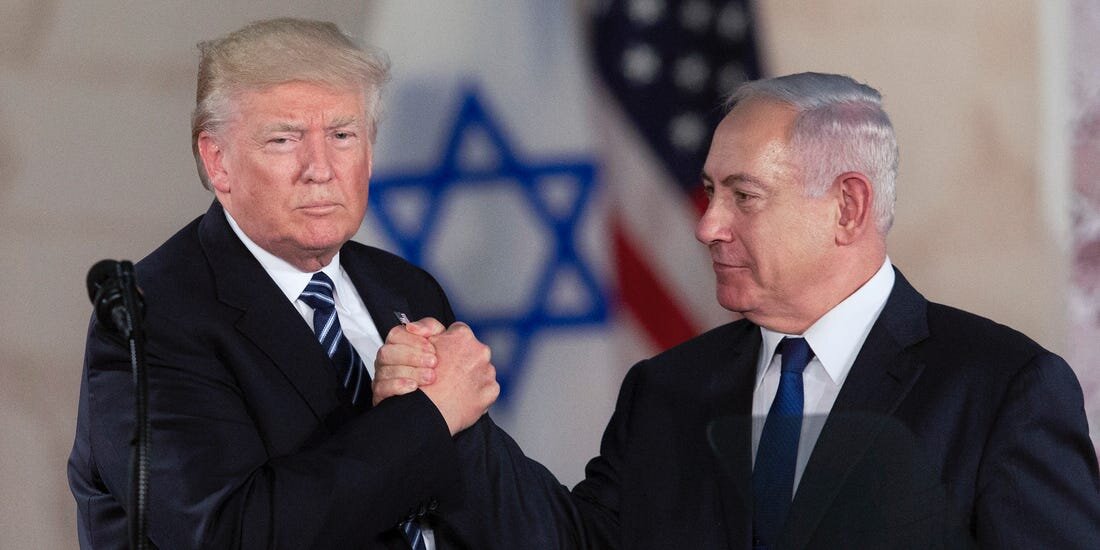Not Worth Negotiating: Trump's Peace Plan Undermines the Palestinians
Benjamin Netanyahu and Donald Trump.
What if you were tasked with solving a 103-year-old conflict? Not many people could draft a viable solution, regardless of the amount of time given.
While the task seems impossible, especially considering the religious, historical, and political forces that have propelled the war since its inception, most people would at least begin by fairly including both parties in peace talks.
In November 2017, the Palestinian Authority (PA) sternly warned Jared Kushner, a senior advisor to President Trump and the architect of his Middle East peace plan, that moving the U.S. embassy in Israel to Jerusalem would "have disqualified [the U.S.] from playing any role in the peace process."
Nevertheless, on Dec. 6, Trump haughtily announced the Embassy move. A few months later, as if his original message wasn't clear enough, he made the decision to close Palestine's mission in Washington DC, removing all Palestinian diplomats from the country.
Following the Embassy move, the PA had no interest in engaging in and legitimising negotiations with the Trump administration. So, when wondering whether the Palestinians should have come to the negotiating table after the announcement of Trump's infamous "Deal of the Century", one has to first ask themselves whether the rest of the negotiating table is even willing to listen to Palestinian needs.
In order to provide some context to the plan, let's take a look at who designed it; namely, Benjamin Netanyahu. Shortly after his prime-ministerial election in 2009, he established his parameters for a potential deal with the Palestinians.
His demands for a fully demilitarized Palestinian state, Jerusalem to become the undivided capital of Israel, and for Palestinian refugees to be denied access to their Arab relatives in Israel were all scarily similar to the 53 pages of Trump's peace plan that set out the two-state "solution".
Netanyahu has been pivotal in dictating the tone of the lengthy document, and it’s clear that instead of writing the plan themselves, Kushner's team tasked Netanyahu with completing a game of fill in the blanks, which paired with a few colourful maps, was handed to Trump.
Yet, the demands of Mahmoud Abbas, the President of the PA, were nowhere to be seen on any of the document's 181 pages. In fact, Abbas himself has admitted that Kushner urged him to "wait until the plan is announced" before giving input (he didn't send him an advanced copy of the plan).
Over the past three years, the Trump administration has actively stifled Palestinian voices from the deliberative process. Not only have they denied the right of the Palestinians to have a seat at the negotiating table, but they have also cut $65 million in funding for Palestinian refugees, promising to reinstate the funds only when the Palestinians unequivocally embrace Trump's “Deal of the Century.”
Despite this, the Trump administration continues to publicly argue that the Palestinians can "come and tell us" what minor details they would like to renegotiate, refusing to see that Abbas would need to renegotiate the whole plan for it to justify his people's century-long struggle.
For the sake of changing a few formalities, why would Abbas see the value in subserviently yielding to Netanyahu, a man who was formally indicted for bribery and fraud in Israel on the very day the deal was announced.
Even if Trump had unveiled a plan perfectly suited to the needs of the Palestinian people, how could Abbas accept a deal knowing that the Palestinian people were disregarded in the process of its formation? A quick look back at history will show that the statehood of a nation which is founded on a sense of inferiority will dissolve as quickly as it was forged.
Another reason why the Palestinians should not go to the negotiating table is that they would be legitimizing a plan that is so detrimental to the Palestinian people that it is beyond salvageable.
The map of a two-state solution in the document — which resembles my 3rd grade scatter art project more than anything — divides the Palestinian state into fragmented neighborhoods connected by thin roads, bridges, and tunnels.
The map is best understood next to a map of South Africa's Bantustans, but that would be assuming that the map is actually enacted. Under the deal, a semi-autonomous Palestinian state — its territorial waters, airspace, and crossings would all still be monitored by Israel — would only be achieved subject to Israel's approval of it "in good faith"; Israel's promise of "good faith" is not so reassuring when looking at its foreign policy, especially its evergrowing illegal settlements in the West Bank.
According to the plan, Jerusalem, a city that holds religious significance in Islam, Christianity, and Judaism, would solely be under the political jurisdiction of Israel. This defies the United Nations and its countless resolutions that implore Israel to retreat to its pre-1967 borders.
Trump claims that "East Jerusalem" would be designated as the capital of Palestine. However, what Trump is really saying — in the most Trumpy way possible I might add — is that the Palestinians would be given the suburbs that are located east of Jerusalem, and if they choose to call this piece of land "East Jerusalem", then so be it.
For a conflict that has endured for several generations, it is hard to see how the exclusive negotiations and harsh rhetoric of the "Deal of the Century" could possibly comfort the Palestinians into thinking that the deal is in their best interests.
While the duration of Palestine's continued struggle for self-determination is uncertain, it is certain that this autonomy will never be achieved if the Palestinians come to a negotiating table that bullies them into signing on the dotted line of a pre-negotiated deal.

